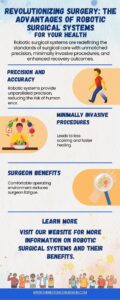In recent years, the field of surgery has undergone a significant transformation with the introduction of robotic surgical systems. These cutting-edge technologies have revolutionized the way surgeries are performed, offering numerous advantages over traditional methods. In this blog, we will explore the innovative features and benefits of robotic surgical systems, and how they are changing the landscape of modern surgery.

Introduction to Robotic Surgical Systems
Robotic surgical systems are advanced medical devices that are operated by skilled surgeons to perform minimally invasive surgeries. These systems consist of robotic arms equipped with surgical instruments, a camera, and a console where the surgeon controls the movements of the robotic arms. The robotic arms are designed to mimic the movements of the surgeon’s hands, but with greater precision and dexterity.
Advantages of Robotic Surgery
- Precision: One of the key advantages of robotic surgery is its precision. The robotic arms can make movements with a high degree of accuracy, allowing surgeons to perform complex procedures with greater precision than is possible with traditional surgical techniques.
- Minimally Invasive: Robotic surgery is minimally invasive, which means that it involves smaller incisions than traditional surgery. This leads to less pain and scarring for the patient, as well as faster recovery times.
- Enhanced Visualization: Robotic surgical systems are equipped with high-definition cameras that provide surgeons with a clear, magnified view of the surgical site. This allows for greater accuracy and precision during surgery.
- Improved Ergonomics: Robotic surgery offers improved ergonomics for surgeons, as they can perform procedures while sitting comfortably at a console. This reduces the physical strain on surgeons and allows for longer, more complex surgeries to be performed.

Applications of Robotic Surgery in Oncology
Robotic surgical systems are increasingly being used in the field of oncology to treat various types of cancer. Some common applications of robotic surgery in oncology include:
- Prostate Cancer Surgery: Robotic surgery is commonly used to remove the prostate gland in patients with prostate cancer. This procedure, known as a prostatectomy, is performed with greater precision and accuracy using robotic surgical systems.
- Gynecological Cancer Surgery: Robotic surgery is also used to treat gynecological cancers such as cervical, endometrial, and ovarian cancer. Robotic surgery allows for more precise removal of cancerous tissue, leading to better outcomes for patients.
- Colorectal Cancer Surgery: Robotic surgery is increasingly being used to treat colorectal cancer. Robotic systems allow surgeons to perform complex procedures with greater precision, leading to better outcomes and faster recovery times for patients.
Future Directions of Robotic Surgery
The future of robotic surgery looks promising, with ongoing advancements in technology and surgical techniques. Future developments may include improvements in robotic arms, enhanced imaging technologies, and the integration of artificial intelligence to assist surgeons during procedures.
Conclusion
In conclusion, robotic surgical systems have revolutionized the field of surgery, offering numerous advantages over traditional surgical techniques. From increased precision and accuracy to faster recovery times, the benefits of robotic surgery are clear. As technology continues to advance, the role of robotic surgery in oncology and other fields of medicine is expected to grow, offering new hope for patients and surgeons alike.




